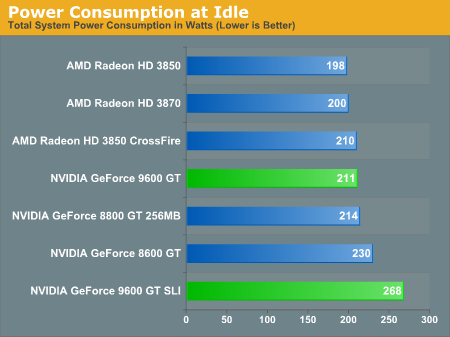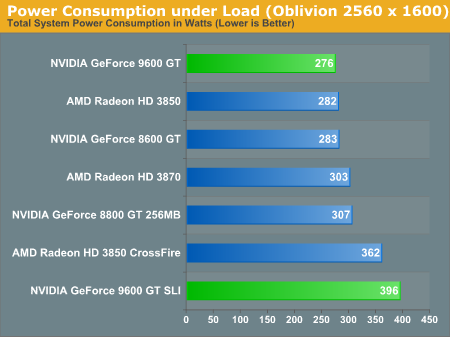Bringing Competition to Midrange: The GeForce 9600 GT Raises NVIDIA's Sub $200 Bar
by Derek Wilson on February 21, 2008 9:00 AM EST- Posted in
- GPUs
The Card and The Test
The Hardware
Palit provided us with a rather amazing little 9600 GT, but we received it a little later than our EVGA parts and we didn't have two of the Palit cards to test SLI either. We've done our testing here with the parts EVGA sent us, but there are some very interesting 9600 GT parts coming out.
The Palit part absolutely deserves a mention, and we will be testing it out as soon as we get a chance. Among the notable features is the fact that Palit has provided not only 2 dual-link DVI ports, but interfaces for both HDMI and DisplayPort. There is also an optical SPDIF input on the back enabling audio to be sent over HDMI.
But let's get back to the hardware at hand. NVIDIA reports that the GeForce 9600 GT will draw about 95W in real world apps. This means it does require a PCIe power connector to provide the added juice over the 75W available from the motherboard via the PCIe x16 slot.


The reference design used by EVGA is single slot and makes use of a fan shroud that covers the entire front face of the card. The Palit card we received is a two slot solution, but the main reason for this seems to be the inclusion of all the added I/O. The EVGA part isn't very loud, but we will be interested in comparing the noise levels between the reference design and Palit's larger solution to see if there is any real advantage from going with the wider model.
Our Test Setup
All of today's tests were performed on the 64-bit version of Windows Vista running on a monster of a system. We test all of our graphics cards on high end hardware in order to eliminate the bottlenecks associated with anything but graphics. This means it isn't likely that our numbers will reflect what our readers will see when actually playing a game, but what it does show is which video card is actually capable of providing a better experience when in a situation where graphics processing is the bottle neck.
Isolating the graphics subsystem is important for a few reasons. We can't know what is in your system and we haven't (yet) been able to test every graphics card with every CPU and system memory configuration out there. If you run a system slower than our test bed, you may run into CPU or system memory limited situations, in which case average frame rate won't be governed only by the GPU.
So why is graphics card selection still important? Because the graphics card has the most impact on graphics quality and performance of any single component in the system, and because even in highly CPU limited situation we can still see slow frames come along and throw the GPU a curve ball. Having a more powerful GPU in your system will provide a smoother experience even in CPU limited situations that show less difference between two competing solutions. In a system limited case, dropping in a higher performance GPU will also enable you to turn on more features. We can't decide what eye candy is "better" as every gamer is different and will make their own trade offs. And for new GPU launches, we don't have the time to benchmark every permutation of every setting in every game we test.
The bottom line is that better performance from a GPU in a high end system will translate to more flexibility with options and smoother performance in a lower end system.
Here is our test configuration:
Test Configuratoin
| Test Setup | |
| CPU | 2x Intel Core 2 Extreme QX9775 @ 3.20GHz |
| Motherboard | Intel D5400XS (Skulltrail) |
| Video Cards | ATI Radeon HD 3870 ATI Radeon HD 3850 256MB ATI Radeon X1950 XTX NVIDIA GeForce 8800 GT 256MB NVIDIA GeForce 9600 GT 512MB NVIDIA GeForce 8600 GTS |
| Video Drivers | Catalyst 8.2 ForceWare 169.28 ForceWare 174.12 (9600 GT only) |
| Hard Drive | Seagate 7200.9 120GB 8MB 7200RPM |
| RAM | 2xMicron 2GB FB-DIMM DDR2-8800 |
| Operating System | Windows Vista Ultimate 64-bit |
Power Tests
We did run some power tests, but keep in mind that they will be a little high due to the fact that this is, afterall, Skulltrail we are running.


AMD's hardware shines at idle power with CrossFire even coming in below the 9600 GT. NVIDIA absolutley remains competitive in terms of power consumption under load, which is good to see.










49 Comments
View All Comments
ritalinkid18 - Monday, February 25, 2008 - link
I think this review underestimated the price difference. The key here is cost. It said that cost wasn't a factor when comparing the two in question, but then used as a factor when comparing the SSC to the 8800 gt. The 8800gt's pricetag makes cost a big factor.Not to mention the SLI vs Crossfire, which is undoubtably the 9600gt's win. ( Case and point: http://www.anandtech.com/video/showdoc.aspx?i=3234...">http://www.anandtech.com/video/showdoc.aspx?i=3234... ) This may be about cost and a cost saving upgrade down the road should be included.
The fact that the 9600gt is the clear winner here in completely understated.
7Enigma - Monday, February 25, 2008 - link
Derek and Anand I had a quick question. I, like several others, would have preferred you to have a high(er) end card like the 3870 or 8800GTS (or even just the 512meg version of the GT). I understand the purpose of the review is to show mid-range cards, but its the SLI configuration that annoys me.In a recent Daily Tech article the author eludes to 2 of these 9600's in SLI being a "better" value than a single more expensive GTS (since the 9600's would technically be less expensive). The problem with this statement as we all know is that it is software dependent on whether the extra card will actually be implemented well. Otherwise you have a single 9600 that would get blown away by a GTS. Unfortunately less informed readers of DT that then come over to Anandtech for the review would be shown the 9600 in SLI as the leader.
I understand you don't want to muddy the graphs/charts with the last 100 video cards you have reviewed, so here is my question:
7Enigma - Monday, February 25, 2008 - link
While its great to use the latest and greatest CPU/RAM/Mobo (to make sure the system is GPU constrained), is it possible to stick with a static testbed for at least a couple months (say 3-6)?
Reason being, right now if you had not switched from a QX9650 to a QX9775 between your last review (3870X2), and not switched from Vista 32-bit to 64-bit, we could possibly check back and compare to previous reviews to do our own comparisons. I understand driver revisions are going to still be a factor but as long as we don't see large differences in performance between the drivers it could be a good comparison.
7Enigma - Monday, February 25, 2008 - link
To keep things even more consistent between reviews just keep a HD image of the drive and reformat back to the same static testbed whenever doing a video card review (more expensive but easier would be just a HD swap). We understand you cannot have a dedicated system that doesn't do anything but review video cards, but if you could quickly just swap out a HD or reformat to the same state as a previous review that would end these constant questions about, "Why didn't you test so and so?".
You could then say, "Look it up yourself!"
Here's the quote from the DT article in question:
"As far as performance goes, NVIDIA claims a couple 9600 GT's in SLI mode will perform slightly better than a single 8800 GTX. With the cost of an 8800 GTX still above the $400 price point, the 9600 GT SLI setup is a better investment. Just to mention it, NVIDIA states the 9600 GT puts out twice the frame rates as the 8600GTS when comparing SLI performance."
7Enigma - Monday, February 25, 2008 - link
test7Enigma - Monday, February 25, 2008 - link
Testjamynn - Monday, February 25, 2008 - link
Why are the results for Crysis, Oblivion and Quake Wars 880GT 256 so much lower in this article than they are in their original review in this article? http://www.anandtech.com/video/showdoc.aspx?i=3175...">http://www.anandtech.com/video/showdoc.aspx?i=3175...Definetly makes the 880GT256 look alot worse than it originally tested. Looks Suspicous.
MadBoris - Saturday, February 23, 2008 - link
Ok, I was waiting for this review to popup on the home page but it never did on my visits why is that?It seems now I have to scour the site, in this case the video section, to look for it on some whim. The home page has really become disappointing, sometimes it shows an interesting blog but doesn't include this review, the home page is doing a disservice to visitors. I hope you guys can fix that or start sending all new content to the home page.
Secondly, I would have really liked a comparison to the 8800GT 512 in this review, the question to me is the 8800GT 512, for only $20 - $30 more, worth it over this card.
niva - Friday, February 22, 2008 - link
I still have my Tyan Tachion 9700 Pro in my 6 year old system and runs just fine and I use every day for office/email/internet and gaming! Of course I don't run any of the stupid games which require new gen cards. I'll keep it until it dies I think. Ultimate card evar though at the time it came it was high end as heck!Seriously though, we should all be happy that we actually HAVE a mid-price range market now. I am, thanks Nvidia!
Groovester - Thursday, February 21, 2008 - link
It seems strange that no mention was made of the 8800GS card. Perhaps it wasn't available when AT decided to test the 9600, but it would be nice had they tested the two. After all, they are NVidia's two newest mid-range video cards. According to the 8800GS specs, if they are going to retail for about the same price, it looks like the 8800GS would perform better. And I doubt that I would be using the new color "saturater" of the 9600.